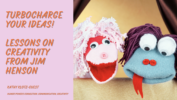UK Campaign: Save the Children Storytelling Lessons
My friend, lovely human being and fellow storyteller, Park Howell, shared the following campaign from Save the Children with me recently. It’s a powerful and touching piece of storytelling:
Save the Children Storytelling Lessons
Great storytelling does a number of things to pull us in. This particular video uses a few techniques that are effective in highly emotionally charged stories. Here are a few Save the Children Storytelling Lessons that can be applied to your brand or business storytelling:
- Role Reversals and Status Shifts. Many stories end on an arc where characters change status. Change is an important part of storytelling and in long-form improv, status changes happen frequently. They work because they take us on a more emotionally satisfying journey. For example, the janitor who is honest is elevated; the corrupt boss is brought down. In this case, the entire premise is built on a role reversal that is up-front – not at the end. A role reversal is an effective way to build empathy right way – what if this were you? “What if…?” is a powerful way to create a vision and world that might be; it allows your audience to put themselves into that world. It becomes *their* world, not someone else’s. And of course, it uses status because now we are talking about kids from a first-world country. If this were to happen in the US or UK, would we allow it? Probably not. That at its core is what this story is about: the plight of children.
- Rapid cuts (edits). Rapid cuts jump us forward in time, so we see a future period in very quick succession in order to see how bad the situation is. It’s an emotional impact because we see the effect the conflict has on the character – in this case a young British girl.
- Time and urgency. Related to number 2, the quick moving forward in time allows us to see how the character is affected over a longer period. And we could even jump further in time as she ages – that creates urgency in a serial storytelling approach.
- Show, don’t tell. While it’s effective to have the main character talk about how they feel, it is always powerful to show it visually. We see her facial expressions and we know. If this were a written story, we would need more information about how the character feels inside. Visually, her facial expressions say it all. We know she is sad and scared, we don’t need her to articulate it verbally.
- Escalating conflict. How the character tries to cling to some normal on a journey marked by violence, fear, separation – every hurdle imaginable, makes her endurance more heroic. Some people might say this can backfire. Sure, there’s always that risk except for the fact that the violence depicted here is accurate – it’s what many Syrian refugees experience every day. It’s not exaggerated for storytelling; it’s based on truth. The escalation of violence also underscores and further magnifies the truth and the urgency of the situation.
- Call to action. There is a call to action at the end of the video. We, the viewers, are called to join the movement to set things right, make a difference and deliver hope. That is a powerful call. Will you answer it? It’s an invite to something bigger. That’s the power of great storytelling and a call to action.
This is by far one of the most effective video stories I have seen recently. Through the lens of a child, we see the horror of this humanitarian crisis.
Your Turn
What Storytelling Lessons do you draw from this campaign?



